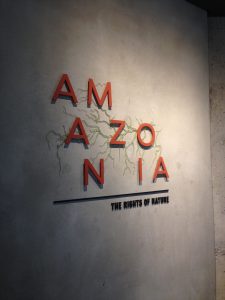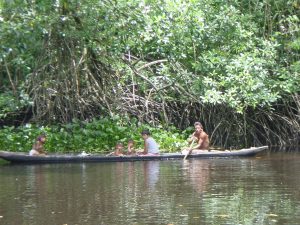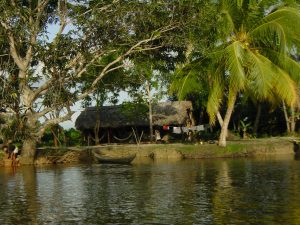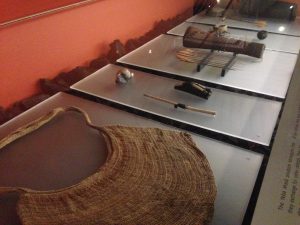
For our joint CAP lecture we were required to visit the Museum of Anthropology, which was a great excuse to go since I had never made it out that way. It was honestly a breathtaking experience to walk into the MOA. Totem poles decorated the light-filled room with floor to ceiling windows. Even before entering the exhibit I was in awe and filled with a sense of serenity and peace. Exploring the Amazonia exhibit was an equally beautiful experience. This exhibit was particularly interesting to me since I spent four years of my formative life living in Venezuela and had travelled to Peru and Ecuador during this time. This exhibit reminded me of my upbringing livingn in South America. Being in this exhibit made me reflect on my past and reminded me of a distinct memory from when my family and I travelled to the Orinoco Delta and whilst on this visit interacting with the Warao indigenous people (which translate to Canoe people, since this was their main mode of transportation). We travelled to these remote villages via boat and experienced their lifestyle (see photos below from my travels there).

The Warao people canoeing on the Orinoco Delta

Since I was only four at the time I did not think too deeply about this experience however looking back it has made me ponder about how this interaction must have been for the Warao people. To me it seemed slightly odd to see grown ups only partially clothed, my day to day experiences suggested that clothes was a normal part of life. Yet, to them they lived isolated from other groups and therefore must have been an equally, if not more, of a surprising experience. These thoughts filled my mind as I explored the exhibit, especially when reading about colonists who had come into indigenous villages exploited and slaughtered them. Knowing this history how do these minority groups feel when tourists come through to “watch” them live? Is it ethical to bring tour groups to view indigenous groups as if they are on display, almost like a human zoo? These are just some of the questions that arose during this visit.
The entire exhibit featured a myriad of artefacts from displays of headdresses, hammocks to baskets. Each was fascinating but the one that I found of particular interest was the tool that was used for hunting, the blow gun (see photo below). I had heard of this tool before but what struck me was the process behind it. Blow guns were made by the Yerba Masā, who excelled in hunting. Hunting was more than just a process of gaining meat, but a study of plants (which were used to make curare-a poison), animals and their behaviours. Due to this, hunting was connected to shamanism. Hunting was not just a process of obtaining meat for survival but instead was considered a transcendental connection and exchange between the hunter and the spirit of the animal. This made me think of the stark comparison to that of the meat corporations that dominate North America. The process of hunting is not common and instead to attain meat is a disconnected experience. People go to the store, choose their meat and go home. There is no spiritual appreciation to the animal.

One major issue revolving around the Amazon (that I did research on my grade 11 and 12 year on) is the amount of environmental degradation and deforestation that is occurring as a result of agriculture, but more specifically cattle production. This is dangerous on both a social and environmental level. To read about how there is a intrinsic connection between indigenous groups and their land makes this dilemma even more frustrating. Their land is being taken from them, used in ways that are against their beliefs and depleted for the means of making profit. Cattle production has led to 65-70% of all the deforestation that has taken place in the Amazon. Moreover, the Amazon is home to 10% of the entire world’s species, 20% of the world’s birds, 2.5 million insects (which are the support structure of an ecosystem) and 40,000 plant species. Each of these species face imminent danger on the daily and the reason for this is because of the dominant Eurocentric view of using the environment as a way to make money.
This relates to what we have been discussing in our geography class and this concept of territory and the discrepancy in views between indigenous groups and European colonists. For example, in America when European colonists first encountered Natives they saw them as not using the land to its “full” potential and believed that land should be owned by the person who uses it most efficiently. Yet this is completely open to interpretation. To indigenous groups they respected and shared the land and used it to the amount they needed, saving it from depletion. Eurocentric views held the perspective that land was at the mercy of humans and should be used to its maximum potential regardless of the consequences. This is no different to what we see now in our modern day society. It is angering but also challenges us all to think what our responsibility is in these situations.
Upon my visit to the MOA, it made me very happy to see how much effort the museum has put into trying to respect the groups native to BC and the Amazonian indigenous groups. Entering the Amazonia exhibit I grabbed the pamphlet and was pleasantly surprised to see that written below the title was, “The Rights of Nature”. Following this, the inside of the pamphlet had used part of the Rights of Nature (from Ecuador) that expressed that nature has rights to regenerate “life cycles, structure, functions and evolutionary processes”. It was refreshing to see such emphasis of the importance of preserving nature. This made me more appreciative to be living in a city that places a lot of significance on respecting our environment and maintaining it to our best ability. This attitude, I imagine, could be easily taken for granted by the people who have been born and raised here. Moving from Hong Kong where there was no recycling system in place or any attitude of preserving the environment it is encouraging to see such a big difference in attitude, especially an attitude aligned so closely with my own.